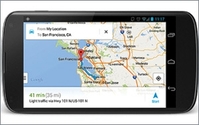Commentary
Where Is That Location Data From, Anyway?
- by Mark Walsh @markfwal, July 16, 2014
 If location targeting is an increasingly common feature of mobile campaigns, then demand for accurate location data is also sure to rise. Research released in May by Thinknear, the mobile advertising arm of wireless location services firm Telenav, found that only
about a third of impressions that carry latitude and longitude data were accurate to within 100 meters of a user’s actual location. And 42% were off by two miles or more.
If location targeting is an increasingly common feature of mobile campaigns, then demand for accurate location data is also sure to rise. Research released in May by Thinknear, the mobile advertising arm of wireless location services firm Telenav, found that only
about a third of impressions that carry latitude and longitude data were accurate to within 100 meters of a user’s actual location. And 42% were off by two miles or more.
The findings only confirmed what has long been talked about as the dirty secret of location-based advertising: bad data flooding the market through the use of “inferred” lat-long data in the absence of device-based GPS coordinates. That leads to advertisers wasting money to reach consumers who aren’t near where they’re supposed to be.
To help marketers become more savvy about location-based campaigns, the Interactive Advertising Bureau recently released a “buyer’s guide” to mobile location data, listing questions advertisers and agencies should ask publishers and location technology providers before taking the leap.
In regard to place data (where places are in the physical world), for example, the document suggests asking questions such as:
-- What is the source of your “place” information (i.e. data about what businesses, points of interest or addresses are found at specific lat/longs in the physical world)?
-- What is your overall share of 1st vs 3rd party place data (e.g., Do you have a proprietary mapping system/address data or utilize a 3rd party database)?
-- What is your approach to organizing places/place data (e.g., polygons, geo-fence radii, etc.)?
And for device-based data:
-- What types of device location data do you use? -- e.g. device GPS, cell tower/triangulation, user-reported (check-in), user reported (registration), Wi-Fi, IPS, beacons, lower power Bluetooth, zip – local content, centroids, NFC, etc.?
-- How do you identify and filter out the types of targetable location data that are not appropriately accurate for my campaign’s needs?
-- How long is your location data stored/considered relevant?
a: Is your device data time-stamped?
b: If you offer dwell times, how are these calculated?
Joe Laszlo, senior director of the IAB’s Center of Mobile Excellence, said in an interview that the new location data guide doesn’t attempt to go beyond laying out informed questions buyers should ask to evaluating the relative merits of one location-targeting approach against another. “We’ll leave that to the Forresters and IDCs of the world,” he said.
It also doesn’t cover location-related topics like privacy and attribution, which the IAB’s Mobile Location Data Working Group plans to address in future reports. Rather, the guide is part of a series of documents the IAB has released about mobile location advertising, including a more conventional overview in 2012, and a set of case studies earlier this year, said Laszlo.
He added that a likely next step for the working group would be “to define some basic principles that, regardless of whether talking about a GPS-based approach or whatever the technology is, should apply across all vendors in the landscape,” regarding location data and targeting. “Disclosure and awareness are the key things.”
Laszlo also acknowledges the need for some type of third-party verification of the accuracy of location data, analogous to the role DoubleClick plays in authenticating online advertising. That’s especially true for location-based ads sold through exchanges, where it becomes even more difficult to discern the source of the data.
Even so, “We’re probably pretty far from that,” said Laszlo. In the meantime, Thinknear is trying to capitalize on the lack of location verification by introducing tools that help marketers assess the quality of location data used in mobile campaigns. The findings the company released this spring stemmed from its Location Score technology.
This week, the company built on that offering by introducing Location Score Tags -- code that marketers can embed in mobile campaign creative to gauge the quality of the location data used. Still, Thinknear President Eli Portnoy suggested the IAB has a role to play in ensuring the accuracy of location data. “Ultimately, I do think the IAB will help set standards for the industry so that each marketer won't need to independently verify the methodology and effectiveness of each location-based vendor,” he said. It just may not be anytime soon.



